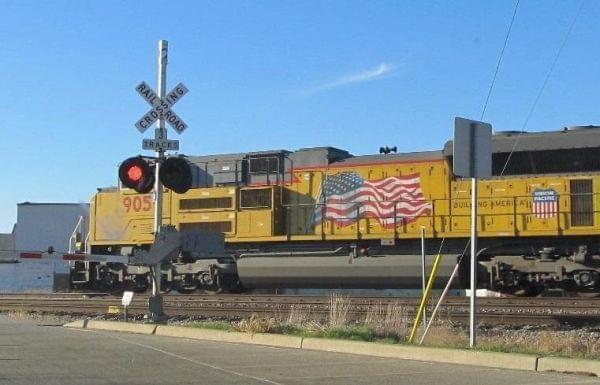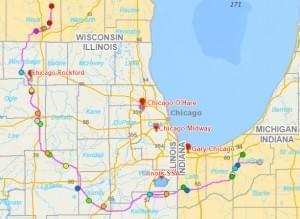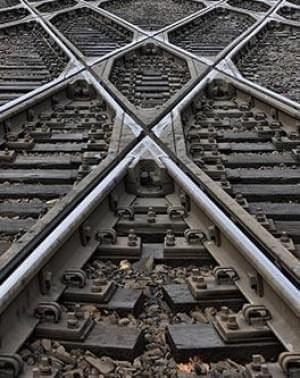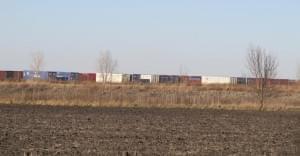Rochelle, GLBR Agree On Its Economic Potential, But Major Railroads Aren’t On Board

A UP train crossing through Rochelle, Ill. Guy Stephens / WNIJ
The argument for the Great Lakes Basin Railroad is that it will be an economic driver for the region. But while some are enthusiastic about its potential, some are skeptical – including the railroads that are supposed to be its major clients.
Great Lakes Basin Railroad lawyer Mike Blaszak says the line will be a boon for the railroads using it -- and for their customers. He cites the example of fracking sand that is mined in Wisconsin.

The map of the Great Lakes Basin Railroad proposed route.
“The sand goes through the Chicago Terminal; it takes a long time to get through the city," he says. "If it were to go on the Great Lakes Basin Railroad, it would go through in a matter of hours, and that would have the benefit of less money tied up in sand inventory, and more efficient use of the railroad cars and locomotives that are moving that sand from Wisconsin to these oil fields in Pennsylvania and Texas.”
That’s just one example, Baszak says. Blaszak also says it would also give the railroads more flexibility.
“Norfolk Southern and CSX, the two Canadian railroads -- Canadian National and Canadian Pacific -- which operate through Chicago, and the other smaller regional lines they would connect with. They would now have the option rather than just dealing with BNSF or UP, through us they could deal with anybody and they could send shipments to more places,” he says.
The GLBR says the line also will provide important connections as well as flexibility for businesses in the region.
Rochelle Says Its History Could Be Region’s Future
Jason Anderson agrees the line could provide enormous benefits. He’s the economic development director for the city of Rochelle. He says the city's experience with its municipal railroad shows the value such a plan can have.

Intersection of UP and BNSF lines in Rochelle
“The city of Rochelle railroad has been an economic development engine for over 30 years,” Anderson says. “It’s attracted over 15 industries to the community, over 2,000 jobs. We are very, very pleased with the outcomes we have had -- how we’ve been able to connect our short-line railroad system with the two Class 1 railroad systems that actually crisscross the city of Rochelle.”
He’s referring to the Union Pacific and the Burlington Northern Santa Fe railroads. Their lines cross in the city -- there's even a park at the crossing with an observation platform for train watchers because of the number of trains going through -- and Anderson can point to a number of projects, such as the re-location of railcar maker Nippon Sharyo to Rochelle, that had rail access as a key component.
Anderson says the region is crossed by or is near seven interstate highways and four Class 1 railroads. So if you expand Rochelle’s model out to the region encompassed by the GLBR, there are tremendous possibilities – possibilities he thinks should be explored.
“The GLBR is a connector,” Anderson says. "That’s what it is, it’s a connector. And by connecting all these transportation assets, as I call them, together, we as communities need to know how we can leverage that, and turn that into something very positive.”
No Railroads on Board
But there’s a problem. None of the Class 1 railroads that are being touted as the main clients for connection have signed on to the project. Most have said nothing. Norfolk Southern and Union Pacific have both stated publicly they’re not planning to use it. When WNIJ asked Union Pacific its current position, it responded that “it was not interested in moving forward with a discussion on the Great Lakes Basin Railroad's bypass project -- an exceedingly expensive idea with no publicly identified funding sources. We have repeatedly communicated this position to Great Lakes Basin's leadership team and associated organizations.”
Union Pacific, like the other major carriers, has committed resources to CREATE, the huge public-private effort to improve the flow of rail traffic through the Chicago area.
The other major railway passing through Rochelle, BNSF, did not respond to inquiries. For others, actions may speak louder than words.

Train cars near Rochelle, Ill.
Just a few years ago the Canadian National railroad bought a rail line that forms a ring around the outskirts of the Chicago area, with the expressed intent of diverting some of its trains away from the congestion of the city and inner suburbs. It now connects to BNSF and other railroads. In a sign of its commitment to the ring line, when cities along the line complained of problems caused by the increase in trains, CN reluctantly agreed to provide a greater-than-usual share of the funding for several overpasses and other traffic mitigation projects to help gain approval for the route.
Next Stop?
Anderson says communities and businesses should take a thorough look at all the pros and cons of the GLBR and make plans accordingly. But with none of the projected users on board, the viability of the line’s business model is still very much in doubt. That makes a commitment to use the line a doubtful enterprise as well.
- The Rockford area remains ambivalent about the GLBR's economic impact. Read Chase Cavanaugh's report.

